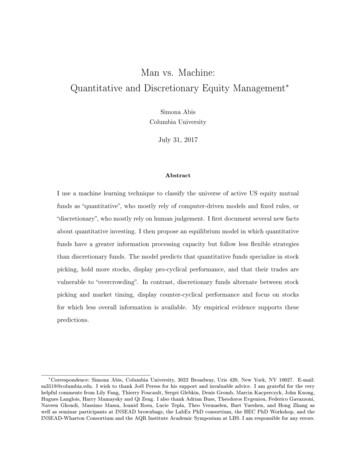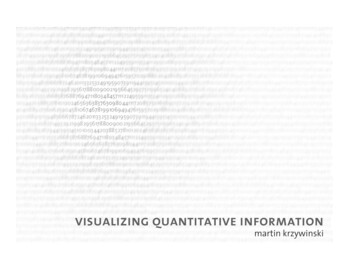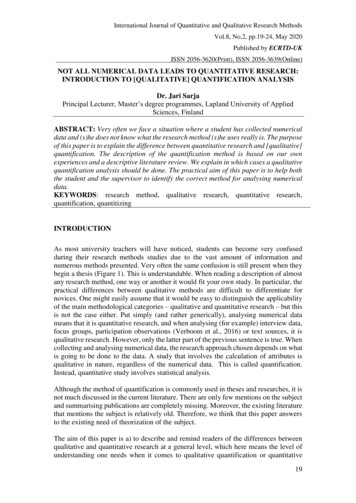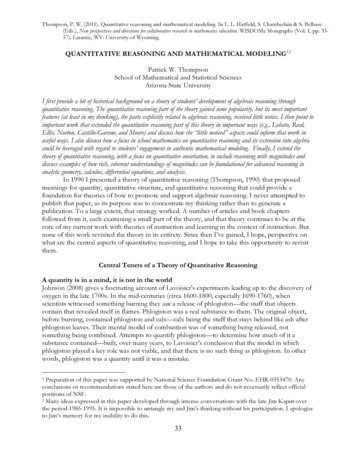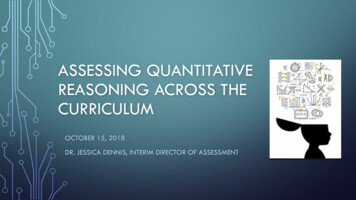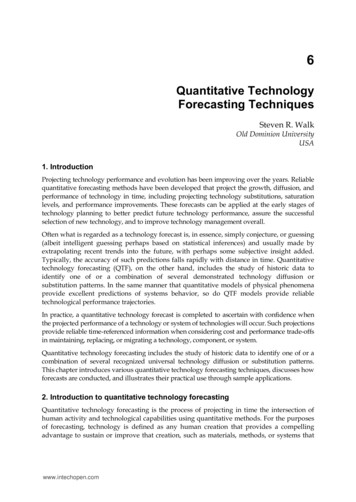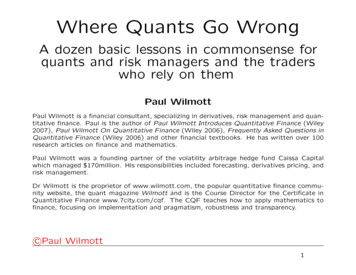
Transcription
Unintended Consequences of the Dodd–FrankAct on Credit Rating Risk and CorporateFinanceBina SharmaBellevue University College of Businessbisharma@bellevue.eduBinay K. AdhikariUniversity of Texas at San Antonio Alvarez College of Businessbinay.adhikari@utsa.eduAnup AgrawalUniversity of Alabama Culverhouse College of Businessaagrawal@cba.ua.edu (corresponding author)Bruno R. ArthurUniversity of Texas at Rio Grande Valley Vackar College of Business and Entrepreneurshipbruno.arthur@utrgv.eduMonika K. RabarisonUniversity of Texas at Rio Grande Valley Vackar College of Business and Prior research finds that Dodd–Frank Act’s regulations on credit rating agencies (CRAs)increase rated firms’ risk of rating downgrades, regardless of their credit quality. Our difference-in-difference estimates suggest that after Dodd–Frank, low-rated firms, which face steepcosts from a further downgrade, significantly reduce their debt issuance and investmentscompared to similar unrated firms. Our results are not driven by credit supply or the financialcrisis. They reveal an unintended consequence of Dodd–Frank: Greater regulatory pressure onCRAs leads to negative spillover effects on firms concerned about credit ratings, regardless oftheir credit quality.I.IntroductionCredit ratings play an important role in market participants’ decisions aboutlending, investing, and managing credit risks. Credit ratings are also important forfirms’ financial decisions. For instance, Graham and Harvey’s (2001) survey findsWe thank Mehran Azimi, Alex Butler, David Cicero, Soroush Ghazi, Incheol Kim, Sandy Klasa, LeiKong, Mina Lee, and conference and seminar participants at the FIRS-Savannah and the Universities ofAlabama, New Orleans, and Texas Rio Grande Valley for useful comments. Special thanks are due to ananonymous referee and to Jarrad Harford (the editor) for helpful suggestions. Agrawal acknowledgesresearch support from the William A. Powell, Jr. Chair in Finance and Banking. Earlier drafts of thearticle were called “Dodd–Frank Act, Credit Rating Agencies and Corporate Financing and /S0022109021000831 Published online by Cambridge University PressJOURNAL OF FINANCIAL AND QUANTITATIVE ANALYSIS Vol. 57, No. 6, Sept. 2022, pp. 2286–2323 The Author(s), 2022. Published by Cambridge University Press on behalf of the Michael G. FosterSchool of Business, University of Washington. This is an Open Access article, distributed under the termsof the Creative Commons Attribution licence (https://creativecommons.org/licenses/by/4.0), which permitsunrestricted re-use, distribution and reproduction, provided the original article is properly cited.doi:10.1017/S0022109021000831
that a majority (57%) of CFOs consider credit ratings as important or very importantin deciding the amount of debt financing. Numerous reports in the news media alsosupport the view that firms take preemptive financial decisions to protect their creditratings.1 Manso (2013) warns that credit rating downgrades can create feedbackloops that affect a firm’s solvency and threaten its survival (e.g., lower ratings !higher interest rates ! optimal default decision ! lower ratings).Despite their key role in financial markets, credit rating agencies (CRAs)sometimes make mistakes, which can have serious consequences for the financialsector (see, e.g., White (2010)). The recent financial crisis has sparked renewedinterest in credit ratings and CRAs, mainly because of their role in the ratings ofstructured financial products. But even before that, credit ratings have been frequently criticized for being inflated, riddled with conflicts of interests, and evenuninformative and inaccurate (see, e.g., Jeon and Lovo (2013)).The upshot is that even though credit ratings may be flawed, they can havetremendous implications for financial market participants. Several studies haveexamined how credit ratings affect firm value and policies, but most of them doso by using the levels of, or changes in, firms’ existing credit ratings.2 In general,it is challenging to separate the effect of credit ratings per se from the effect of creditrisks because they are correlated. In this study, we exploit the passage of the Dodd–Frank Wall Street Reform and Consumer Protection Act (henceforth, Dodd–Frank),which increased the risk of credit rating downgrades for firms, even without achange in their underlying credit quality (see Dimitrov, Palia, and Tang (DPT)(2015)). We examine whether this effect of Dodd–Frank affected the financing andinvestment policies of some firms for which credit rating downgrades, regardless offundamentals, are particularly costly.In response to the 2008–2009 financial crisis, the U.S. Congress passed Dodd–Frank in 2010 to prevent another financial crisis. Dodd–Frank enacted sweepingnew regulations to many parts of the financial services industry. CRAs came underfire and became a significant subject of Dodd–Frank because their ratings ofstructured financial products were believed to be an important contributor to thefinancial crisis. Many provisions of Dodd–Frank subject CRAs to much stricterregulations, as we discuss in more detail in Section IIIA. For example, the lawmakes it easier to bring private lawsuits against CRAs for issuing faulty creditratings. The law also gives the Securities and Exchange Commission (SEC) substantially greater power to impose sanctions on CRAs for potential wrongdoing,including the ability to effectively derecognize their ratings.1For example, the Wall Street Journal (2001) reports AT&T’s plans for shrinking debt to avoid ratingdowngrades by selling some of their cable systems and their stake in Japan Telecom. The New York Times(2009) reports GE’s decision to cut dividends and preserve cash partly because of the concern that themain rating agencies would lower the company’s credit rating.2Prior studies examine the effects of ratings on stock and bond prices (see, e.g., Hand, Holthausen,and Leftwich (1992), Ederington and Goh (1998), and Kisgen and Strahan (2010)), debt and equityissuance (see, e.g., Kisgen (2006), (2009)), debt structure and specialization (see, e.g., Rauh and Sufi(2010), Colla, Ippolito, and Li (2013)), and local credit supply (see Adhikari, Cicero, and Sulaeman(2021)). Kisgen (2006) exploits the features of existing ratings to separate the effect of credit ratings fromcredit risk.https://doi.org/10.1017/S0022109021000831 Published online by Cambridge University PressSharma, Adhikari, Agrawal, Arthur, and Rabarison 2287
As DPT (2015) argue, these reforms were intended to improve the quality ofcredit ratings by encouraging CRAs to invest more in due diligence, improve theirrating methods, monitor their analysts, and strengthen internal controls. However,as Goel and Thakor (2011) suggest, the penalty for issuing erroneous credit ratingstends to be asymmetric because CRAs are more likely to be penalized for issuingoptimistic ratings than for pessimistic ratings.3 DPT find that CRAs were able tocircumvent much of the additional regulatory cost imposed by Dodd–Frank byexploiting this simple insight. They empirically show that CRAs responded to theseregulations with “cheap fixes” by simply issuing lower credit ratings, possiblybelow the levels justified by firm fundamentals. After Dodd–Frank, CRAs issuemore pessimistic credit ratings, which are less informative and contain more falsewarnings of default. DPT document strong evidence of how Dodd–Frank changedthe incentives and behavior of CRAs. Because credit ratings play a critical role inmany firms’ financial decisions, an important follow-up question is whether andhow this change in CRAs’ incentives, in turn, affects financing and investingdecisions of firms rated by these agencies. To the best of our knowledge, there isno systematic evidence on this issue.We attempt to fill this important gap in the literature. We exploit the passage ofDodd–Frank into federal law as an exogenous shock to the risk of firms’ creditrating downgrades. We examine whether this risk influences the financing andinvestment policies of firms most affected by them. One strength of our approach isthat it allows us to cleanly identify the causal effect of ratings on firm policiesbecause Dodd–Frank increased the risk of credit rating downgrades, even without achange in firms’ underlying credit quality. Our identification strategy relies on thefact that, in general, below-investment-grade (henceforth, low-rated) firms facemuch steeper costs of rating downgrades, so they are more likely to respond toan increased risk of downgrades than other firms. (We discuss this issue in moredetail in Section II.) Our inferences are based on variation in firms’ ex ante risk ofdowngrades and do not depend on whether these firms are actually downgraded. Wetest this hypothesis against a null hypothesis that there is no difference in financingand investment decisions between these 2 groups of firms because credit marketsunderstand the changing incentives of CRAs, so firms do not expect to be adverselyaffected by downgrades that happen after Dodd–Frank.Using both the full sample and a sample of carefully matched firms, we findthat after Dodd–Frank, low-rated firms (i.e., the treated group) issue significantlyless debt than a similar group of unrated firms (i.e., the control group), which are notaffected by the risk of rating downgrades.4 The reduction in debt issues is not offsetby an increase in equity issues, forcing these firms to cut back their net investment.The economic magnitudes of these effects are substantial. Based on the full sample,the decline in net new security issues (net investments) represents an 85% (24%)reduction for low-rated firms after the shock compared to their unconditionalpreshock averages. Our results are consistent with the notion that increased concern3In a related article, Goel and Thakor (2015) theoretically explain CRAs’ choice of a coarse ratingscale as a trade-off between their incentives for rating inflation and accuracy.4We find generally similar results when we use investment-grade firms as an alternative controlgroup. We discuss our choice of treatment and control firms in more detail in Section II.https://doi.org/10.1017/S0022109021000831 Published online by Cambridge University Press2288 Journal of Financial and Quantitative Analysis
about potential downgrades, even without a change in the underlying credit quality,forced noninvestment-grade firms to reduce debt issuance and cut back on investments. This is an unintended consequence of Dodd–Frank.We consider and test several alternative supply-side explanations of our mainresults stemming from the fact that the Dodd–Frank Act and the financial crisis thatpreceded it affected many aspects of the financial system apart from CRAs. Thesetests try to separate the effect of credit rating risks from other possible confoundingeffects.5 One alternative “better information” hypothesis posits that CRAs becomemore careful after Dodd–Frank, issuing more informative ratings, and that resultsin disproportionally more downgrades for low-rated firms. Under this story, therevelation of these firms’ poorer credit quality, rather than their ratings per se, makeslenders less willing to lend to these firms. A second alternative “credit supplyshock” story is that Dodd–Frank affected banks’ incentives and ability to lendbecause it introduced regulations on banks’ asset holdings, disclosure, governance,securitization, etc. Third, the financial crisis affected the liquidity and demand forcorporate bonds, especially speculative-grade bonds. Therefore, our results may bedriven by shocks to the supply of debt capital (bank loans and bonds), which mayhave affected our 2 groups of firms differently. Moreover, these differential effectsmay have lingered during the postcrisis years.We conduct several cross-sectional tests, each of which examines one or moreof these supply-side stories. First, we use Kisgen’s (2006) plus or minus (POM) test,which exploits the features of existing ratings to separate the effects of underlyingcredit risk from the risk of a rating downgrade. These POM tests reveal that Dodd–Frank’s effects on debt issuance are largely driven by a demand effect (i.e., firmsrefrain from issuing debt to guard against the risk of a downgrade). Second, weinvestigate whether the risk of being downgraded is made worse by negativeliquidity shocks to the junk bond market, which would support the credit supplyshock story. Following Chernenko and Sunderam (2012), we measure negativeliquidity shocks to the corporate junk bond market by the aggregate net outflow offunds to junk bond mutual funds. We find no significant effect of these adverseliquidity shocks on debt issuance by treatment firms. This result does not supportthe credit supply shock explanation of our results. Third, we find that low-ratedfirms reduce both public (bond) and private (e.g., bank) debt, which indicates thesefirms’ (demand side) decision to reduce debt. Because ratings are more importantfor public bonds than private debt, the information hypothesis would predict areduction in public debt only, which is a supply-side effect. Fourth, our resultsremain robust after controlling for the possibility that low-rated and unrated firmsdiffer in their reliance on bank debt. A final test suggests that treatment firms’response to Dodd–Frank cannot be explained by their differential exposure to thelingering effects of the financial crisis compared to control firms.We further find that treatment firms’ responses to Dodd–Frank vary with theimportance of debt capital to them. For instance, Dodd–Frank leads to a sharperdecrease in debt issuance and investments for low-rated firms that exhibit a higherdemand for debt capital before Dodd–Frank. Moreover, Dodd–Frank’s effectsare attenuated in the presence of institutional investors, which make firms less5We discuss these tests in detail in Section VI.https://doi.org/10.1017/S0022109021000831 Published online by Cambridge University PressSharma, Adhikari, Agrawal, Arthur, and Rabarison 2289
dependent on debt (e.g., Grennan, Michaely, and Vincent (2017)). Both theseresults also favor our demand-side story.This study contributes to several strands of the literature. First, it contributesto the literature on the effects of Dodd–Frank. Our article is closely related to DPT(2015), who show that Dodd–Frank distorts CRAs’ incentives and makes themmore inclined to issue lower credit ratings, below those justified by the underlyingcredit risks. We offer an important extension to DPT’s study by uncovering Dodd–Frank’s effect on corporate policies and behavior.Second, this article contributes to the literature on the unintended consequencesof regulation. For example, prior studies uncover unintended effects of the SEC’sshort-swing rule on insider trading in takeover targets (see Agrawal and Jaffe (1995)),the Sarbanes–Oxley Act (SOX) on the demand and supply of directors (see Linck,Netter, and Yang (2009)), the small firm exemption of SOX on firm size (Gao, Wu,and Zimmerman (2009)), the adoption of International Financial Reporting Standards(IFRS) on contractual outcomes (Brüggemann, Hitz, and Sellhorn (2013)), andDodd–Frank Act on credit ratings (DPT (2015)). All these studies examine the effectsof regulations on firms that are directly targeted by the rules. Our novel evidence thatDodd–Frank’s rule targeting CRAs indirectly influenced the decisions of a wideswath of public companies shows that regulatory changes can have widespreadspillover effects, which policymakers need to consider.Third, the article contributes to the emerging empirical literature that exploitsexogenous shocks to firms’ credit ratings that happen without any change in theunderlying credit risk to study the importance of credit ratings per se for firmpolicies. The shock in Tang (2009) is Moody’s credit rating refinements thatattached numerical modifiers to broad rating classes. Almeida, Cunha, Ferreira,and Restrepo (2017) use the shock to firms’ credit ratings caused by sovereignrating downgrades, given rating agencies’ policies that require firms’ ratings to be ator below the sovereign rating of their country of domicile. We add to this line ofresearch by exploiting an exogenous regulatory event that led to an increase in theex ante probability of being downgraded, without a change in the underlying creditrisk. Finally, the article contributes to the literature on asymmetric effects of creditrating uncertainty on investment and noninvestment-grade firms (see, e.g., Kisgen(2006), Jorion and Zhang (2007), and May (2010)).II.Treatment and Control GroupsWhich firms are likely to be most affected by Dodd–Frank’s regulations onCRAs? Although provisions of Dodd–Frank apply to all credit ratings assigned byCRAs, numerous studies have shown that changes in credit ratings affect lowerrated firms considerably more than higher-rated ones.6 For instance, Jorion and6See, for example, Katz (1974), Griffin and Sanvicente (1982), Holthausen and Leftwich (1986),Cornell, Landsman, and Shapiro (1989), Hand, Holthausen, and Leftwich (1992), Hull, Predescu, andWhite (2004), Jorion, Liu, and Shi (2005), and May (2010). The literature points to 2 main reasons forthis nonuniform effect of credit ratings. First, noninvestment-grade bonds face the most significantliquidity issues, mainly because regulations prohibit many institutional investors from investing in them.Second, noninvestment-grade bonds also face higher regulatory scrutiny and uncertainty (see, e.g.,Lemmon and Roberts (2010)).https://doi.org/10.1017/S0022109021000831 Published online by Cambridge University Press2290 Journal of Financial and Quantitative Analysis
Zhang (2007) show that credit rating downgrades lead to large negative marketreactions among firms with lower prior credit ratings and virtually no effect onhigher-rated firms. May (2010) finds a stronger market reaction to rating changes inbond markets among speculative-rated firms. Kisgen’s (2006) tests reveal that exante credit rating concerns affect debt issuance decisions of low-rated firms muchmore than those of investment-grade firms.Rating downgrades affect some firms much more than others because thedifferences in default rates, and hence the cost of capital, between adjacent ratingsare much larger among low-rated firms than among investment-grade firms. Forinstance, Hamilton and Cantor (2005) estimate a 3-year cumulative default probability among Aaa, Aa, A, Baa, Ba, and B rated issuers in a stable outlook to be 0%, 0%,0.44%, 1.24%, 4.64%, and 17.86%, respectively. Clearly, the consequence of beingdowngraded from Ba to B is much more severe than being downgraded from Aa to Afor ex ante default risk. Similarly, Jorion and Zhang’s (2007) estimates show that thedifference in default probabilities between the firms with AAþ and AA ratings is 0.3percentage points, whereas this difference between BBþ and BB is a whopping 4.7percentage points, or about 15 times as large. This vast skewness in default probabilities faced by firms in different rating classes is also reflected in the differences intheir cost of debt. For instance, Damodaran’s estimates suggest that in 2013, borrowers rated A paid a mere 15 basis points more than Aþ rated borrowers in defaultspreads on average. On the other hand, this difference between Bþ and B ratedborrowers was about 100 basis points.7 The fact that low-rated firms face a massivelysteeper cost of rating downgrades makes them an ideal treatment group for this study,which focuses on the increased ex ante risk of downgrades due to Dodd–Frank.8We follow prior studies (e.g., Lemmon and Roberts (2010)) and use firmswithout credit ratings as the control group. Because unrated firms face no risk ofcredit rating downgrades, they serve as the cleanest benchmark for isolating thedifferences that arise purely due to credit rating shocks, after controlling for otherdifferences that are important for financing and investment decisions. For robustness, we also experiment with investment-grade firms as the control group and findgenerally similar results.III.A.Background, Related Literature, and HypothesisDevelopmentDodd–Frank and Regulation of CRAsDodd–Frank was signed into federal law by President Barack Obama on July21, 2010, as a response to the financial crisis of 2008–2009. Dodd–Frank imposes7Source: Professor Aswath Damodaran’s website: http://www.stern.nyu.edu/ adamodar/pc/archives/bondspreads13.xls.8Note that firms rated BBB arguably also are a candidate for our treatment group. They are in thelowest end of investment-grade rating, so presumably the consequence of a one notch downgrade to junkstatus is very high for them. However, we argue that compared to the decision of downgrading a firmwithin investment or junk category, CRAs are likely to face a stronger backlash for downgrading aninvestment-grade firm to junk grade, unless it is strongly justified by its underlying credit quality.Therefore, we do not include firms rated BBB in our main treatment group. However, includingBBB rated firms in the treatment group does not change our results 00831 Published online by Cambridge University PressSharma, Adhikari, Agrawal, Arthur, and Rabarison 2291
several new regulations on banks, nonbank financial companies, and CRAs. CRAsbecame a primary target of Dodd–Frank because inaccurate and inflated ratings ofstructured financial products, especially subprime mortgages, are believed to havebeen an important factor that contributed to the crisis.Specifically, Sections 931–939 of Title IX (Investor Protections and Improvements to the Regulations of Securities), Subtitle C (Improvements to the Regulationof Credit Rating Agencies) introduce several new rules for CRAs and nationallyrecognized statistical rating agencies (NRSROs).9 Most of these rules becameeffective immediately, so they likely affected CRAs’ behavior right away. Theserules emphasize that because of the systemic importance of credit ratings, functionsof CRAs and NRSROs are matters of “national public interest.” Therefore, theseagencies’ roles should be subject to the same higher standard of public oversight,accountability, and liability as auditors, security analysts, and investment bankers.Greater liability and regulatory penalties are arguably the two most sweepingchanges brought about by Dodd–Frank concerning CRAs.10 Regarding the former,Dodd–Frank makes it much easier to bring private lawsuits against CRAs underRule 10b-5 of the securities law for failing to conduct a reasonable investigationof securities they rate and issuing erroneous credit ratings. CRAs are subject togreater disclosure of their internal controls, rating methodologies, due diligence,and verification of the accuracy of already assigned ratings. These provisions alsoinstruct the SEC to establish an Office of Credit Ratings to monitor the CRAs’internal control systems and rating procedures. Section 932 gives the SEC greaterpower to suspend or revoke an NRSRO’s registration of a particular class ofsecurities for issuing inaccurate ratings.B.Related Literature and HypothesesHow do CRAs respond to Dodd–Frank’s sweeping new rules? DPT (2015)argue that since CRAs are rarely accused of issuing pessimistic ratings, they caneffectively circumvent Section 932 by issuing slightly pessimistic ratings. Ourstudy builds on DPT, who find that after Dodd–Frank, CRAs started issuing morepessimistic ratings, regardless of the borrower’s underlying credit quality. Ourhypotheses are also guided by Kisgen’s (2006) credit rating–capital structure(CR-CS) theory and empirical evidence, as we discuss below.The traditional trade-off theory of capital structure postulates that firms optimize their capital structures based on the trade-off between the benefits (e.g.,interest tax shield and governance) and costs (e.g., bankruptcy risk) of debt. Thetrade-off theory predicts an inverse U-shaped curve for the relation between debtratio and firm value. On the other hand, the CR-CS theory argues that ratingsconvey information on firm quality beyond other publicly available information.Therefore, rating changes can trigger events that lead to discrete changes in costs or9An NRSRO is a CRA that issues credit ratings that the SEC recognizes for certain regulatorypurposes such as ease of bond issuance by firms and meeting certain financial firms’ net capitalrequirements or reserves. See SEC (2003) and Kisgen and Strahan (2010) for more detailed descriptionsof these rules.10See DPT ((2015), Appendix A) for a more detailed summary of these 31 Published online by Cambridge University Press2292 Journal of Financial and Quantitative Analysis
benefits for firms, partly because regulators, investors, and other stakeholders (e.g.,suppliers and contractors) often depend on credit ratings to deal with a firm.As shown by Kisgen, credit rating effects add discrete breaks in the “debt-ratiofirm-value” curve predicted by the traditional trade-off theory of capital structure.An important implication of the CR-CS theory is that 2 identical firms with similarunderlying credit quality, but different credit ratings, can end up with significantlydifferent optimal debt levels. Specifically, the risk of being downgraded oftenmakes the optimal debt level lower than that predicted by the traditional trade-offtheory. Moreover, as discussed in Section II, the cost of being downgraded isgenerally trivial for investment-grade firms,11 but quite significant for low-ratedfirms (e.g., Hamilton and Cantor (2005), Jorion and Zhang (2007), and May(2010)). Therefore, low-rated firms are much more likely to respond to an increasein downgrade risk. These arguments and findings suggest our first hypothesis:Hypothesis 1. Low-rated firms reduce net debt issues after the adoption of theDodd–Frank Act to protect their credit ratings.However, DPT find that after Dodd–Frank, CRAs issue less informative creditratings, which contain more false warnings of default. If borrowers and creditmarkets acknowledge this changing behavior of CRAs, a null hypothesis is thatDodd–Frank does not affect the debt issuance decisions of these 2 groups of firmsdifferently.A firm that is compelled to reduce debt financing has two main choices: eitherto issue equity to continue with the same level of investments or to reduce investments. For several reasons, we do not expect low-rated firms to substitute equity fordebt. First, while Dodd–Frank made debt financing costlier, it is unlikely to havechanged a firm’s investment opportunity set. So, for the same opportunity set,higher a cost of debt likely renders some previously feasible projects infeasible(i.e., turns them from positive net present value (NPV) to negative NPV). Becauseequity is generally more expensive than debt, substituting for equity is also unlikelyto increase the feasible set of investments. Second, it has always been more difficultfor low-rated firms to switch to equity financing (see, e.g., Lemmon and Roberts(2010)). This happens because, in general, bad news for bond markets is also badnews for equity markets, especially for lower-rated firms (see, e.g., Kwan (1996),Jorion and Zhang (2007)). So, higher downgrade risk after Dodd–Frank is unlikelyto have improved these firms’ access to equity markets. Moreover, Kadapakkam,Meisami, and Wald (2016) show that because of a wealth transfer effect, low-ratedfirms are not able to issue new equity when their outstanding debt becomes riskier.These arguments and findings suggest our second hypothesis:Hypothesis 2. Low-rated firms reduce net investments due to the reduction in debtfinancing after the adoption of the Dodd–Frank Act.11Except perhaps when they are downgraded to speculative grade, which is infrequent and unlikelyto happen purely to circumvent Dodd–Frank’s regulations. To deal with this issue, we follow Lemmonand Roberts (2010) and require the sample firms not to switch from investment grade to speculativegrade or vice versa during the sample period.https://doi.org/10.1017/S0022109021000831 Published online by Cambridge University PressSharma, Adhikari, Agrawal, Arthur, and Rabarison 2293
A null hypothesis is that low-rated firms do not reduce net investmentsbecause, for reasons discussed earlier, they are not forced to reduce debt issuance.IV.A.Data and Summary StatisticsSample DescriptionOur empirical strategy largely builds on Lemmon and Roberts (2010), so wefollow an approach similar to theirs to select our sample and design some of ourtests. We consider July 2010, when Dodd–Frank passed, as our event date. Oursample period starts in 2005 and ends in 2015 so that we have a balanced time framearound the passage of Dodd–Frank. We obtain S&P domestic long-term issuercredit ratings from Compustat and supplement these with Moody’s and Fitch’s bondratings obtained from Mergent Online database. Table A1 in the Appendix presentsa short description of the credit ratings assigned by these 3 agencies. We define afirm as unrated if it does not have a credit rating from any of these agencies.Following the industry convention and prior literature, we consider credit ratingsof AAA to BBB (or equivalent) as investment grade and BBþ to C (or equivalent)as below-investment (also called noninvestment or speculative) grade.12 We dropfirms assigned “D” and “SD” from the sample because these ratings are assigned tofirms currently in default on their financial obligations.We obtain financial and stock price information from Compustat/CRSP mergeddatabase. We exclude financial and utility firms from the sample because theseindustries are highly regulated. We require all firm-year observations to have nonmissing and nonnegative values for total assets, sales, capital
bruno.arthur@utrgv.edu Monika K. Rabarison University of Texas at Rio Grande Valley Vackar College of Business and Entrepreneurship monika.rabarison@utrgv.edu Abstract Prior research finds that Dodd-Frank Act's regulations on credit rating agencies (CRAs) increase rated firms' risk of rating downgrades, regardless of their credit quality.
